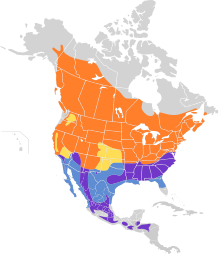Chipping sparrow
| Chipping sparrow | |
|---|---|

| |
| Adult in breeding plumage | |
| Scientific classification | |
| Domain: | Eukaryota |
| Kingdom: | Animalia |
| Phylum: | Chordata |
| Class: | Aves |
| Order: | Passeriformes |
| Family: | Passerellidae |
| Genus: | Spizella |
| Species: | S. passerina
|
| Binomial name | |
| Spizella passerina (Bechstein, 1798)
| |

| |
| Synonyms[2] | |
| |
The chipping sparrow (Spizella passerina) is a species of New World sparrow, a passerine bird in the family Passerellidae. It is widespread, fairly tame, and common across most of its North American range.
The chipping sparrow has five subspecies.[3][4] This bird is a partial migrant with northerly populations flying southwards in the fall to overwinter in Mexico and the southern United States, and flying northward again in spring.
It molts twice a year. In its breeding plumage it has orangish-rust upper parts, gray head and underparts and a distinctive reddish cap. In non-breeding plumage, the cap is brown and the facial markings are less distinct. The song is a trill and the bird has a piercing flight call that can be heard while it is migrating at night.
In the winter, Chipping Sparrows are gregarious and form flocks, sometimes associating with other bird species. They mostly forage on the ground for seeds and other food items, as well as clambering on plants and trees, feeding on buds and small arthropods. In the west of their range they breed mainly in coniferous forests, but in the east, they choose woodland, farmland, parks and gardens. Breeding starts in late April and May and the nest is often built in a tree.
Description

Throughout the year, adults are gray below and an orangish-rust color above. Adults in alternate (breeding) plumage have a reddish cap, a nearly white supercilium, and a black trans-ocular line (running through the eye). Adults in basic (nonbreeding) plumage are less prominently marked, with a brownish cap, a dusky eyebrow, and a dark eye-line.
Juvenile chipping sparrows are prominently streaked below. Like non-breeding adults, they show a dark eye-line, extending both in front of and behind the eye. The brownish cap and dusky eyebrow are variable but generally obscure in juveniles.
Measurements:[5]
- Length: 4.7–5.9 in (12–15 cm)
- Weight: 0.4–0.6 oz (11–17 g)
- Wingspan: 8.3 inches (21 cm)
Breeding

The male chipping sparrows start arriving at the breeding grounds from March (in more southern areas, such as Texas) to mid-May (in southern Alberta and northern Ontario). The female arrives one to two weeks later, and the male starts singing soon after to find and court a mate.[6] After pair formation, nesting begins (within about two weeks of the female's arrival). Overall, the breeding season is from March till about August.[7]
The chipping sparrow breeds in grassy, open woodland clearings[6] and shrubby grass fields.[7] The nest is normally above ground but below 6 metres (20 ft) in height,[6] and about 1 metre (3.3 ft) on average,[8] in a tree (usually a conifer, especially those that are young, short, and thick) or bush. The nest itself is constructed by the female[6] in about four days.[8] It consists of a loose platform of grass and rootlets and open inner cup of plant fiber and animal hair.[7]
The chipping sparrow lays a clutch of two to seven pale blue to white eggs with black, brown, or purple markings. They are about 17 by 12 millimetres (0.67 by 0.47 in), and incubated by the female for 10 to 15 days.[7] The chipping sparrow is often brood parasitized by brown-headed cowbirds, usually resulting in the nest being abandoned.[6]
Feeding
The chipping sparrow feeds on seeds year-round, although insects form most of the diet in the breeding season. Spiders are sometimes taken. Taraxacum officinale seeds are important during spring, and seeds from Fallopia convolvulus, Melilotus spp., Stellaria media, Chenopodium album, Avena spp., and others.[6]
Throughout the year, chipping sparrows forage on the ground[9] in covered areas,[10] often near the edges of fields.[6]
References
- ^ BirdLife International (2021). "Spizella passerina". IUCN Red List of Threatened Species. 2021: e.T22721162A138527131. doi:10.2305/IUCN.UK.2021-3.RLTS.T22721162A138527131.en. Retrieved 29 December 2024.
- ^ Lepage, Denis. "Chipping Sparrow". Avibase - The World Bird Database. Retrieved 29 December 2024.
- ^ "Spizella passerina (Bechstein, 1798)". Integrated Taxonomic Information System. Retrieved 29 December 2024.
- ^ "Spizella passerina (Bechstein, 1798)". Global Biodiversity Information Facility. Retrieved 29 December 2024.
- ^ "Chipping Sparrow Identification, All About Birds, Cornell Lab of Ornithology". www.allaboutbirds.org. Retrieved 2020-09-29.
- ^ a b c d e f g Rising, J. (2018). del Hoyo, Josep; Elliott, Andrew; Sargatal, Jordi; Christie, David A.; de Juana, Eduardo (eds.). "Chipping Sparrow (Spizella passerina)". Handbook of the Birds of the World Alive. Barcelona, Spain: Lynx Edicions. doi:10.2173/bow.chispa.01. Retrieved 2 October 2018.
- ^ a b c d Hauber, Mark E. (1 August 2014). The Book of Eggs: A Life-Size Guide to the Eggs of Six Hundred of the World's Bird Species. Chicago: University of Chicago Press. p. 581. ISBN 978-0-226-05781-1.
- ^ a b Reynolds, John D.; Knapton, Richard W. (1984). "Nest-site selection and breeding biology of the chipping sparrow". The Wilson Bulletin. 96 (3): 488–493. ISSN 0043-5643.
- ^ Allaire, Pierre N.; Fisher, Charles D. (1975). "Feeding ecology of three resident sympatric sparrows in eastern Texas". The Auk. 92 (2): 260–269. doi:10.2307/4084555. ISSN 0004-8038. JSTOR 4084555.
- ^ Lima, Steven L.; Valone, Thomas J. (1991). "Predators and avian community organization: an experiment in a semi-desert grassland". Oecologia. 86 (1): 105–112. Bibcode:1991Oecol..86..105L. doi:10.1007/BF00317396. ISSN 0029-8549. PMID 28313165. S2CID 40449461.
External links
- Chipping sparrow – Spizella passerina – USGS Patuxent Bird Identification InfoCenter
- Chipping sparrow species account – Cornell Laboratory of Ornithology
- "Chipping sparrow media". Internet Bird Collection.
- Chipping sparrow photo gallery at VIREO (Drexel University)
- Interactive range map of Spizella passerina at IUCN Red List maps


